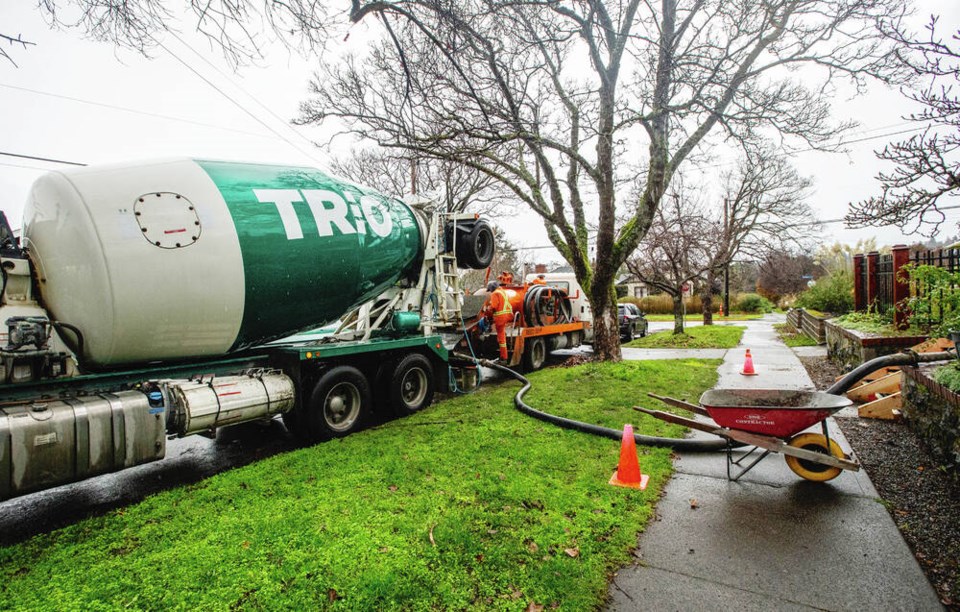The City of Langford’s decision to adopt a low-carbon concrete policy is being hailed by the concrete industry as a major milestone in tackling climate change, and a sign that cities are catching up to the industry’s own commitment to reducing greenhouse gases.
As of June 1, all concrete supplied for public and private construction projects in the city that require more than 50 cubic metres of concrete will have to be produced using carbon dioxide mineralization technologies, or an equivalent that offers concrete with lower embodied carbon dioxide.
That means virtually all projects requiring concrete will need to use a greener form of the material — a 2,500-square-foot home with a basement, for example, uses about 60 cubic metres of concrete during construction.
Carbon mineralization technologies inject captured carbon dioxide into concrete during the mixing process, where it becomes permanently embedded, improving the concrete’s strength so less cement is needed in the mix to achieve the same performance.
Carbon is captured during the cement production process. Cement is the key ingredient in concrete and its production is responsible for about seven per cent of the world’s carbon dioxide emissions.
According to industry experts, Langford is the first city in Canada to adopt this kind of policy, which will set a new standard for cities and could be the catalyst for similar policies around the country.
Langford Mayor Stew Young said establishing new regulation is key to driving change.
“With this policy, Langford is extending its commitment to taking climate action while also setting a new, higher standard for policymakers across Canada to rein in emissions and protect our communities from the worst impacts of climate change,” he said.
Robert Niven, chief executive of CarbonCure, which provides carbon mineralization technology to concrete producers like Butler Brothers and Trio Ready Mix in Victoria, called Langford’s policy a powerful tool and the most ambitious green concrete policy he’s seen globally.
Niven, whose company operates at more than 500 concrete-producing sites on six continents, said when other cities have made similar decisions, it’s taken very little time for others to follow suit.
“If we are to unlock all of the solutions, they need a market signal and there is no bigger market signal than government,” he said. “They are the single biggest buyer of concrete.”
Lisa Bate, past chair of the World Green Building Council, said Langford has provided a blueprint that can be adopted across Canada and beyond.
The World Green Building Council has highlighted the need to revolutionize the construction sector toward a net-zero future, she said. “This policy solution in Langford is a wonderful demonstration of what’s possible.”
Niven said Langford’s decision goes a step further than other cities that have established similar policies, as it also requires project teams to submit an environmental declaration that is third-party verified, allowing Langford to see the climate impact of those building materials.
Langford suggests that report is like a nutritional label for concrete. Niven said it makes Langford a Canadian leader in the deployment of carbon capture, utilization and storage technologies for construction concrete.
“They have said [to industry]: you have to show us the numbers, so there is no risk of greenwashing,” he said, adding as those numbers come in, it is likely to stimulate more green innovation.
While Langford’s new policy may set a new bar for cities to aspire to, local concrete producers have been ahead of the curve in many ways.
Stephen Hay, general manager of Trio Ready Mix, noted his company has been operating a CarbonCure mineralization system for about 18 months, and more recently it added a CarbonCure water technology system.
The water-recycling system, which injects carbon dioxide into the water from truck washouts, returned concrete and other onsite work, allowed Trio to reduce water consumption by about 2.8 million litres.
Hay said the company’s new concrete plant was designed with an eye to emission reduction, noting its concrete-production processes produce 19 per cent less carbon dioxide than they did in 2019.
Langford’s new policy is a good step forward, he said.
“There is a lot of pressure on the building industry to reduce its carbon footprint and I think CarbonCure’s system and other processes will become the norm,” he said. “It’s a positive thing for the industry to show that there are paths to green concrete, and this is taking a step to promote that technology and that process.”



